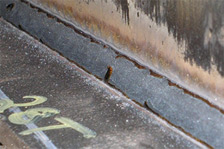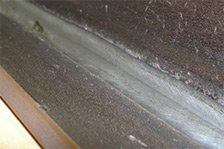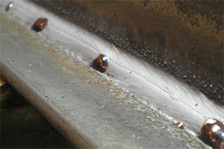| Adam Rolfes, senior welding engineer at Hobart Brothers, a Troy, Ohio based developer and supplier of welding filler metals, prides himself on his ability to match the right welding methods to a customer's application and solve challenging welding problems. But he didn't have a ready answer when some customers recently asked what filler wire he recommends for use with SCS. The reason? Rolfes had not heard of SCS. He and fellow Hobart welding specialist Mike Spodar quickly investigated SCS and learned that it had gained a reputation as being an excellent base material for welding. The applications they read about were intriguing, but they wanted to get some hands-on experience with the product and see for themselves, so they contacted TMW to get SCS samples. |
|||||||||||||
 Welded SCS samples used the Tri-Mark Vantage filler wire and the 90 Ar/10 CO2 shielding gas.  Welded Cold Rolled samples used Tri-Mark Vantage filler wire and a 90 Ar/10 CO2 shielding gas.  Welded Hot Rolled Black used the Tri-Mark Vantage filler wire and a 90 Ar/10 CO2 shielding gas. |
"When the samples came in, we were impressed by how smooth and clean the surface is, given it's hot rolled black as the base," recalled Rolfes. "We figured it would weld as well as quality hot rolled, but we typically see the best results with cold rolled (CRS) . We were curious how well it would stack up against cold rolled in head-to-head comparisons." Design of the Experiment Rolfes and Spodar used 0.250" thick samples of SCS, CRS and Hot Rolled Black (HRB), welding each material only to itself. Using a Motoman EA1400N welding robot and 675 amp capable power source optimized for long cycle MIG welding, they set out to make fillet welds at a consistent travel speed. They were looking to obtain a quality 1/4" bead with minimal spatter. "We used two different filler wires we thought would be especially well-suited to these materials," explained Spodar. "Our Tri-Mark Vantage is a metal cored wire that minimizes the silicon deposits in the weld bead as well as minimizing spatter. Our Quantum Arc 6 is a copper-coated wire that works well with slight surface rust or mill scale because it has a higher deoxidizer content. We read where the SCS Welding Guidelines recommend a 95% Argon/5% Oxygen shielding gas. It made sense to use that mix, but also to use the 90 Ar/10 CO2 mix we often recommend." Results and Recommendations The three materials produced weld beads that were overall uniform with little spatter. The three photos to the left show the beads obtained with the Tri-Mark Vantage wire and 90 Ar/10 CO2 shielding gas. Rolfes observed, "SCS performed slightly better with the 95AR/5O2 shielding gas, just as the guidelines said it would. It had a very smooth and steady arc, and very nice looking beads, although we observed a tendency for the silicon deposit to be lined in the toe of the bead. Overall, the SCS showed itself capable of welding speeds comparable to what can be obtained with clean CRS." Asked to rank the three materials for weldability, Rolfes and Spodar, give a slight edge to clean CRS. They got a very nice bead, the most even silicon dispersion and slightly faster travel speeds with CRS. SCS is a close second, having a very nice bead appearance and good travel speed with the 95AR/5O2 shielding gas. SCS also worked very well with the 90Ar/10CO2 gas and the Hobart experts likened welding |
||||||||||||
|
The SCS to welding high quality shot-blasted hot rolled (not part of the test) . Both agreed that SCS outperforms hot rolled black . What about the other SCS welding advantages, such as reduced pre-welding prep and cleanup and reduced welding fumes since SCS has no oil to burn off? "Everything we've read and seen about those advantages makes sense," commented Rolfes, " but we were not evaluating those factors . . . we were looking strictly at weld quality , travel speeds and what filler wire and gas combinations work best. Our customers are in a better position to evaluate the other SCS advantages, as well as cost advantages over CRS. What is important to us is that now we are prepared to assist them in their choice of welding methods and consumables." |
|||||||||||||
